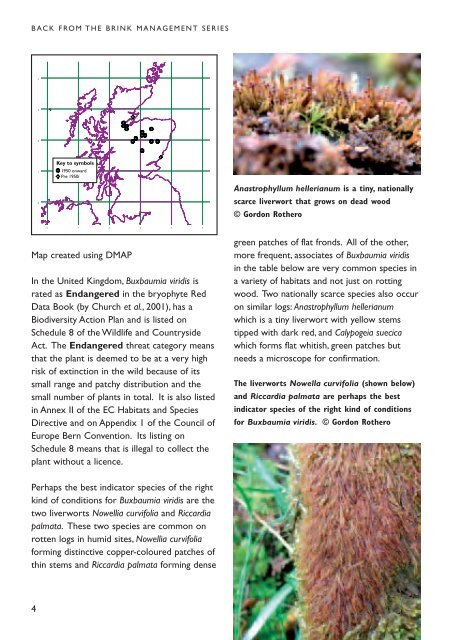Looking after Green Shield-moss (Buxbaumia viridis) and ... - Plantlife
Looking after Green Shield-moss (Buxbaumia viridis) and ... - Plantlife
Looking after Green Shield-moss (Buxbaumia viridis) and ... - Plantlife
You also want an ePaper? Increase the reach of your titles
YUMPU automatically turns print PDFs into web optimized ePapers that Google loves.
BACK FROM THE BRINK MANAGEMENT SERIES<br />
Map created using DMAP<br />
In the United Kingdom, <strong>Buxbaumia</strong> <strong>viridis</strong> is<br />
rated as Endangered in the bryophyte Red<br />
Data Book (by Church et al., 2001), has a<br />
Biodiversity Action Plan <strong>and</strong> is listed on<br />
Schedule 8 of the Wildlife <strong>and</strong> Countryside<br />
Act. The Endangered threat category means<br />
that the plant is deemed to be at a very high<br />
risk of extinction in the wild because of its<br />
small range <strong>and</strong> patchy distribution <strong>and</strong> the<br />
small number of plants in total. It is also listed<br />
in Annex II of the EC Habitats <strong>and</strong> Species<br />
Directive <strong>and</strong> on Appendix 1 of the Council of<br />
Europe Bern Convention. Its listing on<br />
Schedule 8 means that is illegal to collect the<br />
plant without a licence.<br />
Perhaps the best indicator species of the right<br />
kind of conditions for <strong>Buxbaumia</strong> <strong>viridis</strong> are the<br />
two liverworts Nowellia curvifolia <strong>and</strong> Riccardia<br />
palmata. These two species are common on<br />
rotten logs in humid sites, Nowellia curvifolia<br />
forming distinctive copper-coloured patches of<br />
thin stems <strong>and</strong> Riccardia palmata forming dense<br />
4<br />
0<br />
9<br />
8<br />
7<br />
6<br />
Key to symbols<br />
1950 onward<br />
Pre 1950í<br />
0 1 2 3 4 5<br />
Anastrophyllum hellerianum is a tiny, nationally<br />
scarce liverwort that grows on dead wood<br />
© Gordon Rothero<br />
green patches of flat fronds. All of the other,<br />
more frequent, associates of <strong>Buxbaumia</strong> <strong>viridis</strong><br />
in the table below are very common species in<br />
a variety of habitats <strong>and</strong> not just on rotting<br />
wood. Two nationally scarce species also occur<br />
on similar logs: Anastrophyllum hellerianum<br />
which is a tiny liverwort with yellow stems<br />
tipped with dark red, <strong>and</strong> Calypogeia suecica<br />
which forms flat whitish, green patches but<br />
needs a microscope for confirmation.<br />
The liverworts Nowella curvifolia (shown below)<br />
<strong>and</strong> Riccardia palmata are perhaps the best<br />
indicator species of the right kind of conditions<br />
for <strong>Buxbaumia</strong> <strong>viridis</strong>. © Gordon Rothero

















